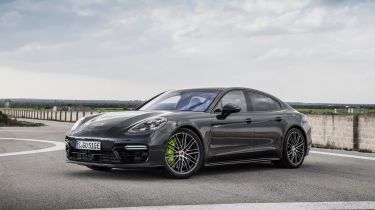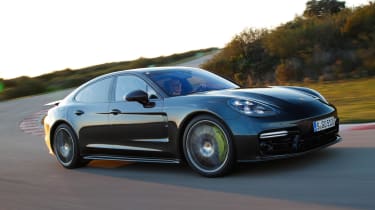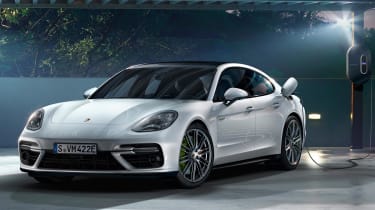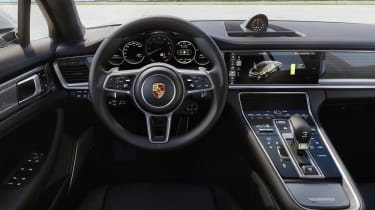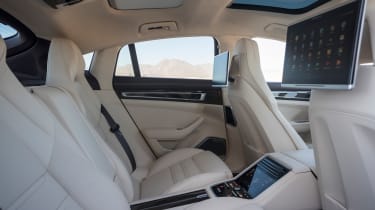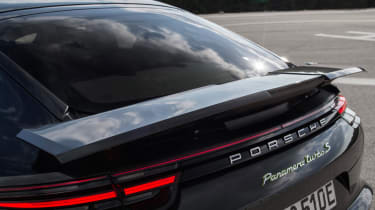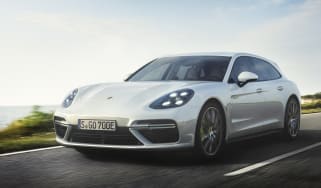Porsche Panamera hybrid (2016-2018)
"The Porsche Panamera hybrid is fast, comfortable and relatively economical – but you have to pay for the privilege"
Pros
- Decent all-electric range
- Very comfortable
- Turbo S very fast
Cons
- Expensive to buy
- Relatively sluggish in electric mode
- Grabby ceramic brakes on Turbo S
The Porsche Panamera range is now wider than ever before, with a choice of five-door hatchback and a rather shapely Sport Tourer estate version. Both can be chosen with Porsche's E-hybrid system, combining petrol and electric power.
And within that, there's a further choice to be made. Entry-level is the Panamera 4 E-Hybrid, which uses a twin-turbocharged 2.9-litre V6, while the Turbo S E-Hybrid pushes performance up several notches thanks to its 4.0-litre V8. Both engines are supplemented by electric power and lithium-ion batteries for an all-electric range of 30 miles, and both offer and an astonishing blend of performance and low emissions.
This isn't a hybrid that prioritses fuel economy, though. Technically, the entry-level car promises 112.9mpg when the battery is fully charged. This figure is entirely reliant on taking full advantage of the car's all-electric mode, though – start exploiting its monstrous performance to the full and its appetite for fuel will increase rapidly.
A look at its specifications list reveal that power is really what the E-Hybrid is all about, with 0-62mph possible in just 4.6 seconds in the Panamera 4, falling to a blink-and-you-miss-it 3.4 seconds in the Turbo S. Top speeds are 172 and 192mph respectively, where it's safe and legal to put them to the test. Incredible figures, especially when you consider the Panamera’s size and weight.
In fact, the Turbo S Sport Tourer can call itself the fastest Panamera – as well as the most powerful estate car – ever made, thanks to the 671bhp available when electric and petrol power works in concert to deliver full acceleration.
More reviews
The Panamera E-Hybrid offers responsive controls, loads of grip from the four-wheel drive system and huge agility in corners to make the best of all that power, too, while the interior is lavish and comfortable enough to encourage you to take your foot off the accelerator and watch the miles slip smoothly by.
The Panamera 4 E-Hybrid doesn’t have many direct rivals, apart from the all-electric, four-wheel-drive Tesla Model S 100D. It’s better to think of it as a competitor to sporty luxury saloons that don’t necessarily feature similar technology, such as the Maserati Quattroporte and Mercedes CLS. It’s a credible alternative to the diesel and petrol variants of those cars – as well as the frugal-yet-powerful Panamera 4S Diesel.
Meanwhile, the Turbo S E-Hybrid sits right at the top of the Panamera range a rival for the top-flight Tesla Model S P100D, as well as more traditional high-end luxury sports saloons like the Aston Martin Rapide S and Bentley Continental Flying Spur.
MPG, running costs & CO2
Plug-in hybrid fuel consumption is measured under laboratory conditions, using a simulated driving cycle that takes full advantage of a car's all-electric range. Until the battery is depleted, it's technically possible to achieve 112.9mpg if you drive a Porsche Panamera 4 E-Hybrid relatively gently, avoiding full acceleration and complying with urban speed limits.
Do the same in the Turbo S E-Hybrid and 97.4mpg should be possible. However, start making use of the powerful petrol engine of either version and fuel economy can be expected to plummet. If you're looking for a Porsche Panamera that doesn't drink a lot of fuel, drivers who don't spend a lot of time driving around town will be better off with one of the still-powerful diesel models.
There's another appeal to the E-Hybrid beyond impressive fuel economy claims and ferocious power – low official CO2 emissions. The E-Hybrid's low 56g/km (66g/km for the Turbo S) figure applies irrespective of how it's driven, which means business users who can claim one as a company-car need only pay a low 13% Benefit-in-Kind tax, compared to the 37% figure for most other Panamera models – a huge potential saving. These emissions figures mean you won't have to pay the Congestion Charge in London, either.
For both cars, first-year road tax will be just £15 (usually rolled into the on-the-road price), but thereafter things get more expensive – the Panamera Turbo S E-Hybrid costs £130 a year to tax and easily exceeds the £40,000 threshold for the £310-a-year surcharge. This is payable at the end of the first year of ownership, and annually for four years thereafter. For year six it reverts to £130.
Other running costs, including servicing, tyres, brakes and car insurance will be similar to any other very high performance saloon car. A Panamera E-hybrid is not a car that can be run on a tight budget.
Engines, drive & performance
Both hybrid Panameras generate plenty of grip and are comfortable. They're fast, too; the addition of an electric motor to already-powerful V6 and V8 engines means there's lots of power available at any time and in any gear. Both feature various programmable driving modes that adjust the overall character of the car, plus adaptive air suspension that can be made stiffer for a sportier experience, or softened for long motorway journeys.
Using the performance of either car – even the ultra-fast Turbo S E-Hybrid – is not a daunting experience. Porsche's clever four-wheel-drive and traction-control systems are very effective, while the wealth of adjustable settings means your hybrid Panamera can be as soft or as sharp as you wish. If you’re a keen driver and like the idea of a hybrid that’s fast, fun to drive and yet still offers fantastic comfort, a hybrid Panamera makes a strong case for itself.
Both cars are quick, with the entry-level hybrid Panamera managing 0-62mph in 4.6 seconds and the S E-Hybrid taking just 3.4 seconds with the aid of a launch-control system. Top speeds in both models are in excess of 170mph and they can both cruise at speeds of up to 86mph on electric power alone, provided there’s sufficient battery charge. Porsche claims the Panamera can travel up to 30 miles on electric power only with fully charged batteries.
The extra weight of the hybrid system means the hybrid Panameras aren't as agile as their conventionally powered equivalents, but the steering remains sharp and Sport+ mode allows you to drive the car quickly on a twisty road with confidence.
The Panamera brakes work well but have downsides on each model. The brake pedal on the 4 E-Hybrid can feel strange thanks to the regenerative systems in place, while the standard carbon-ceramic brakes on the Turbo S E-Hybrid are very powerful but quite grabby, so can be tricky to use smoothly. The normal steel brakes fitted on other Panameras are far nicer to use.
Interior & comfort
Both Panamera hybrids are expensive luxury cars with interiors to match. The interior is well designed, comfortable and covered in high-quality leather and trimmed in a choice of carbon-fibre, wood veneer or brushed aluminium. Standard 14-way power-adjustable seats in the front allow for a perfect driving position, while the two individual seats in the back are similarly comfortable, with lots of room to stretch out. Options like an air ioniser, ambient lighting and ventilated front and rear seats are merely tip of the iceberg if you want to make your Panamera as comfortable and luxurious as possible.
There’s plenty of technology, too, including an intuitive infotainment system that incorporates advanced mobile-phone connectivity features, DAB radio and more, with a large, clear display that's incorporated nicely into the dashboard, supplemented by two smaller displays integrated into the instrument binacle – particularly useful for displaying sat-nav information where it's easy to see. The Panamera comes in standard form, as a long-wheelbase Executive model and in Sport Turismo 'shooting brake' guise.
PRACTICALITY / BOOT SPACE
Although it's perhaps not the most important consideration when buying a high-performance luxury car, the Panamera is practical. It has a good-sized boot under its large rear hatch – 405 litres with the rear seats up, or 1,245 with them folded down, which is larger than in a Mercedes CLS – but 95 litres short of the non-hybrid version.The boot itself is a useful shape and the lip isn't very pronounced, making it relatively easy to load large cases and shopping bags alike. The Sport Turismo version of the car has an estate-style boot and a middle seat for an extra rear passenger.
In the rear, leg and headroom is excellent, especially given the car's sloping roofline. Split-folding rear seats mean that larger loads can be carried along with a single rear passenger if need be, while large doors and an electric tailgate make for easy access to the rear of the car. There’s no middle rear seat, but the two passengers traveling in the back will be as comfortable as in any other car in the class, provided you don't make full use of the performance on a twisty road. The 4 E-Hybrid can also be had with a longer wheelbase, called the Executive model, giving rear seat passengers even more space.
Practicality & boot space
Although it's perhaps not the most important consideration when buying a high-performance luxury car, the Panamera is practical. It has a good-sized boot under its large rear hatch – 405 litres with the rear seats up, or 1,245 with them folded down, which is larger than in a Mercedes CLS – but 95 litres short of the non-hybrid version.
The boot itself is a useful shape and the lip isn't very pronounced, making it relatively easy to load large cases and shopping bags alike. The Sport Turismo version of the car has an estate-style boot and a middle seat for an extra rear passenger.
In the rear, leg and headroom is excellent, especially given the car's sloping roofline. Split-folding rear seats mean that larger loads can be carried along with a single rear passenger if need be, while large doors and an electric tailgate make for easy access to the rear of the car. There’s no middle rear seat, but the two passengers traveling in the back will be as comfortable as in any other car in the class, provided you don't make full use of the performance on a twisty road. The 4 E-Hybrid can also be had with a longer wheelbase, called the Executive model, giving rear seat passengers even more space.
Reliability & safety
Porsche did not feature in this year's Driver Power survey as there was not a large enough sample to draw from. Generally speaking, there’s very little to worry about when buying a Porsche; you can rest assured that it'll be solidly built and very reliable, and the Panamera is no exception.
Not enough Panameras are made to warrant a Euro NCAP crash-test rating, but it’s very likely to be a safe car, with a plethora of safety items including front knee and full-length side curtain airbags, a side-impact protection system and a bonnet that pops up to protect pedestrians from the hard contents of the engine bay in the event of a crash. There's even hi-tech infrared night vision to help detect pedestrians and/or animals in the road beyond the beam of the headlights, which themselves can be upgraded with powered cornering lights and a system that improves illumination at junctions using sat-nav data.
Price, value for money & options
The most direct rivals to the 4 E-Hybrid and Turbo S E-Hybrid are made by Tesla in the form of the Model S 100D and Model S P100D respectively. The 100D costs around £10,000 more than the 4 E-Hybrid, while the P100D undercuts the Turbo S E-Hybrid by the same amount. Both the Model S models are quicker than their Panamera equivalents in a straight line, but the Panamera performs much better in corners.
The options list available to Panamera buyers is extensive and has the potential to vastly increase the cost of the car with just a few ticks of a pen or clicks of a mouse. This is particularly true for the entry-level 4 E-Hybrid model, as the Executive and Sport Turismo versions come with upgrades and the Turbo S E-Hybrid also has more luxuries as standard (which it should given it costs over £50,000 more than the 4 E-Hybrid).
Exactly how much it costs to upgrade to optional extras depends on which Panamera model you buy, but 4 E-Hybrid buyers can upgrade to metallic paint for just under £1,000. There are 15 alloy wheel upgrades that range from around £400 to almost £4,000, while the most expensive 'club leather' interior is also just shy of £4,000. Carbon ceramic brakes are just under £7,000, a sports exhaust system is £2,300, while a Bose surround sound system is £1,000. None of the options can really be classed as 'must-haves' but naturally there are some that look good and/or add extra luxury. Our advice would be to exercise restraint and be as confident as you can that you'll enjoy any options you decide to order, as it's unlikely their cost will be reflected fully in the value of the car when you come to sell it.

